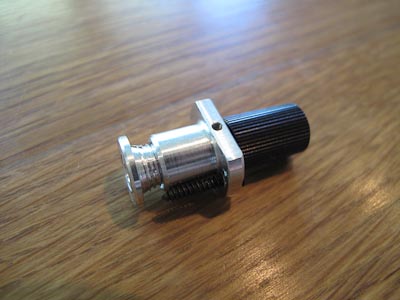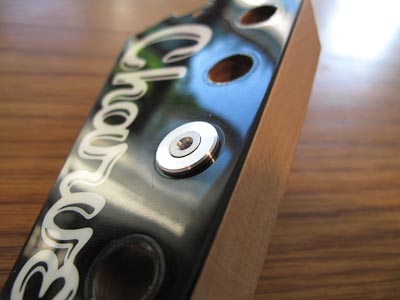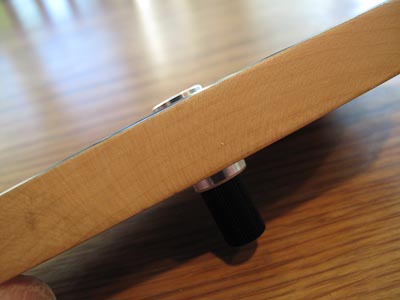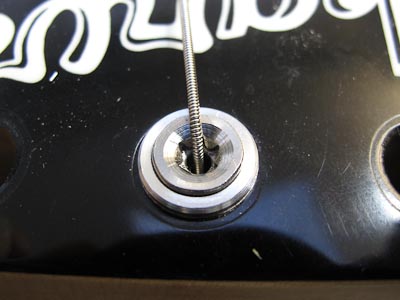I have had a new tuner in the works for some time. The spark was the electric tri-kanta that I am collaborating with luthier Michele Benincaso on. We met again yesterday to discuss it and a new improved version of the string anchors described here.
The key points for the design are: compact mounting, low weight (there will be 36 of them on the tri-kanta), durability, cohesion with the current EGS designs and, last but not least, it should be able to retro-fit into existing instruments to improve ergonomics.
Here are some pictures of the first prototype:




As you can see, it fits into a standard tuner hole. The difference here is that the tuner extends behind the headstock and does not rely on being mounted close to an edge. Additionally, with the low profile, the angle over the nut will be higher possibly eliminating the need for string trees or the use of an angled headstock. It uses the same parts as the current EGS bridges, so the investment in developing them can be leveraged.
The design issue that we discussed yesterday was how to tighten the assembly into the headstock. We do not want any risk of scratching the surface of the headstock in case of having to re-tighten it. Also, visually, we don’t want a large irregular shape visible as would be the case with a hexagon nut like on a normal tuner. Also affecting the appearance and this part of the design is the need for a more durable and replaceable part for the string to slide against. All current parts of this type in the current EGS concept are made from stainless steel for looks and durability. With any type of assembly, there is the issue of how to bond it to the aluminium. We don’t want any risk of this piece falling out on stage during a change of strings. Here is a prototype of a possible solution:


It is made from a stainless steel M5 screw with a recessed head and Torx grip. The remaining Torx grip after rounding the edges can be used to tighten the assembly and is easily replaced.
As always, comments on the design are welcome. The weight? 7 grams. Compared to 35 grams of a regular tuner I found. With a saving of 28 grams per tuner sitting mounted on a headstock 500 mm away from your center of gravity, this really adds up. Removing this weight from the headstock allows you to remove weight from the body and still get a well-balanced instrument. For Paolo and the tri-kanta, it’s a saving of roughly a kilogram compared to normal tuners.




Hola Ola,
I’m so impressed. A couple of quick questions:
This is design is similar to the Steinberger 40:1 tunes, is it not?
Due to the compact design, these could be spaced closer together than say a tradition Fender or Gibson headstock, possibly fitting 10 or 12 on something of the same size?
What is the knob made out of? It’s hard to tell from the photo. What could it be made from, like wood or bone?
Thanks,
Tyler
Hi Tyler,
yes, the design is similar, although there is one important distinction with the current design: the Steinberger tuner has a locking mechanism whereas mine does not but instead relies on the ball end securing the string inside the tuner. So, something is needed to lock the string at the other end (nothing prevents this tuner from being mounted in the body and used with a tune-o-matic bridge) like my string locks. I also have plans for a new tremolo that will simply lock the string and be used with this type of tuner.
These could be mounted in line at a spacing of about 10.5 mm. The knobs are the same that I use in my bridges, i.e. made from anodized aluminium.
Cheers,
Ola
looks very cool, Ola, I like it a lot. Any plans to make them with a locking feature ala the Steinberger Gearless Tuners?
Hi Josh,
I have yet to come up with a robust locking solution. Since this is the same mechanism as the one I use on my bridges, I would be of great value to work one out. But these parts are quite delicate and it is a challenge to come up with a locking solution that fits within the dimensions. It is always in the back of my mind though, and suggestions are welcome!
Cheers,
Ola
I understand, very interested to see what else you come up with. Would also love to see your take on something like the S Trem, with kind of a cam system rather than knife edge. Anyways, love all your work.
Do you plan on making ones that will hold bass strings?
I like these new tuners!
After playing a Steinberger for a few years, I’m convinced I prefer tuners at the end of the neck, not at the body. But, I prefer as light a peg head as possible. Your new tuners are the lightest I’ve seen anywhere.
I like your new tuners just as they are. Simple, light, and robust. I don’t think they need a locking mechanism. These tuners, and your string locks at the location of a traditional tailpiece, would make traditional guitar designs balance much better while reducing total weight.
Do you plan to produce these tuners?
I would also like to use these style tuners on a bass design I’m working on. I expect a bass version would be quite a bit larger, but I think they would still be much lighter than other bass tuners.
I can not express to you how interested I am in this. What is the largest sting gauge these will accept? I want a set for my seven string.
This tuner is based on parts from the regular headless tuner system, which means that double-wound portion of the ball end goes through it. While the hole itself is .1″, depending on the string brand, it will usually accept a .074″ string and sometimes a .080″. But it will require more testing since the angle through the tuner is quite sharp and it might not work that well with heavier gauges.
Realistically, there are higher prioritized projects right now, but I hope to be able to re-visit at a later date.
I understand you very busy right now but if / when you decide to work on this I would be more that happy to be your guinea pig. 🙂